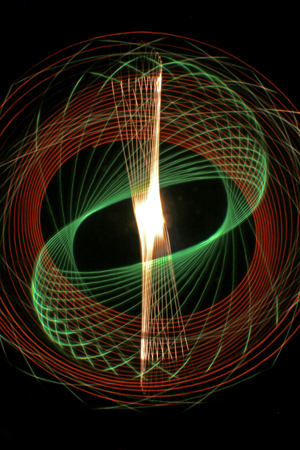 |
| Public domain image by jonfletch |
Physiograms are patterns created by the laws of nature. They have little practical use in the context of photography but can be unusual and great fun to produce. A simple technique for creating such a pattern involves little more than a small torch, suspended from a cord, which is then set swinging in a naturally decaying series of ellipses.
Attach a small, pen-sized torch with a tiny bulb to a piece of string a few feet in length. The other end of the string must be attached to a suitable suspension point such as a domestic light fitting. Set up a camera a few feet beneath the torch, and set the lens aperture to about f/8. Focus the lens on the torch bulb, and turn out all the lights in the room to obtain near total darkness. Switch on the torch and set it swinging in an elliptical path which extends beyond the camera's angle of view, and wait until the path described decays so that it falls totally within the frame. Then open the shutter using the "B" setting and allow the torch to continue swinging for perhaps 30 seconds. The shutter can then be closed.
Physiograms can be varied by placing coloured paper filters over the torch bulb to change the colour of the trace recorded. Two or three different coloured traces can then be recorded on the same image by placing a black card over the camera's lens while the filter is changed and the torch is set swinging in a differently orientated path.






